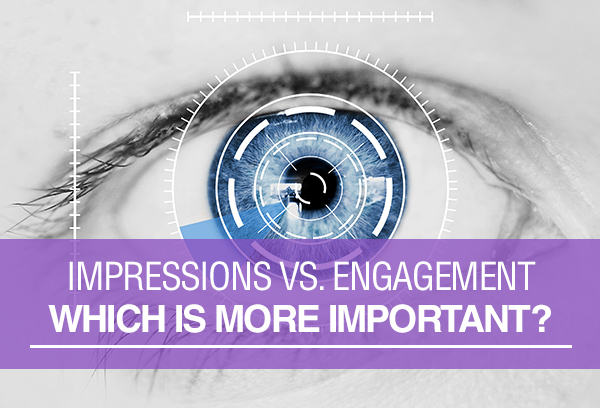 It’s a question most digital marketers have asked themselves time and time again. Should I be more concerned about impressions or engagement?
It’s a question most digital marketers have asked themselves time and time again. Should I be more concerned about impressions or engagement?
From digital ads in online publications, to social media marketing and other consumer-facing digital promotions, the answer simply depends on the goal for that particular digital spend.
- Is your goal to elevate the brand’s visibility to existing audiences?
- Is your goal to increase brand awareness to new audiences?
- Is your goal to begin building a relationship with your audience?
- Or perhaps your goal is to create a dialogue so that you can learn more about your audience?
You see, all are valid marketing goals and good reasons to invest in a digital budget, and in many cases you may have multiple goals. But depending on what those goals are, either engagement or impressions will be a more effective measure of success.
Let’s quickly review the basics of each:
Impressions
Digital impressions simply refers to the number of times an advertisement, Facebook post, tweet, or any other digital content is served up to your audience. Clicks are not taken into account with this number. In most cases, you can choose to base your digital spend on impressions alone, and your budget will be spent each time your ad or post is viewed. This is called CPI or Cost Per Impression.
Engagement
Engagement refers to comments, likes, shares, clicks, retweets or any other measurable interaction with your digital content. The better the content, the more likely your audience will be to engage. When setting a budget with this goal in mind, you can choose to pay per interaction which is called CPC or Cost Per Click.
Impressions vs. Engagement
So as you’ve probably surmised by now, goals that align more with increased engagement are relationship building and dialogue related. Goals that align more with increased impressions include elevated brand visibility or increased brand awareness. The only caveat is that engagement increases as your impressions increase because your potential pool of respondents is growing. If both awareness and engagement are a part of your goals, you may choose to focus a set timeframe on building brand awareness and then change your strategy to brand engagement. This is an effective approach for new ad campaigns, because impressions ultimately lead to engagement. You must get the word out about your brand if you want others talking about and engaging with you.
Wherever you are in your marketing journey and no matter the size of your digital marketing spend, it is important to track and analyze both sets of data for ebbs and flows that inform your budget size and allocation going forward. Somewhere along the way you will identify trends and be able to establish a baseline that defines success for your brand.
Interested in talking more about digital marketing with DMA? Our team of experts is ready to help you define goals, strategize and execute a plan that will take your brand to the next level.
Have something to add? Leave us a comment below, or follow us on Twitter at @TheCoreBlog.
{{cta(‘5de978d7-8c0c-4f83-8388-4d52595702af’)}}











